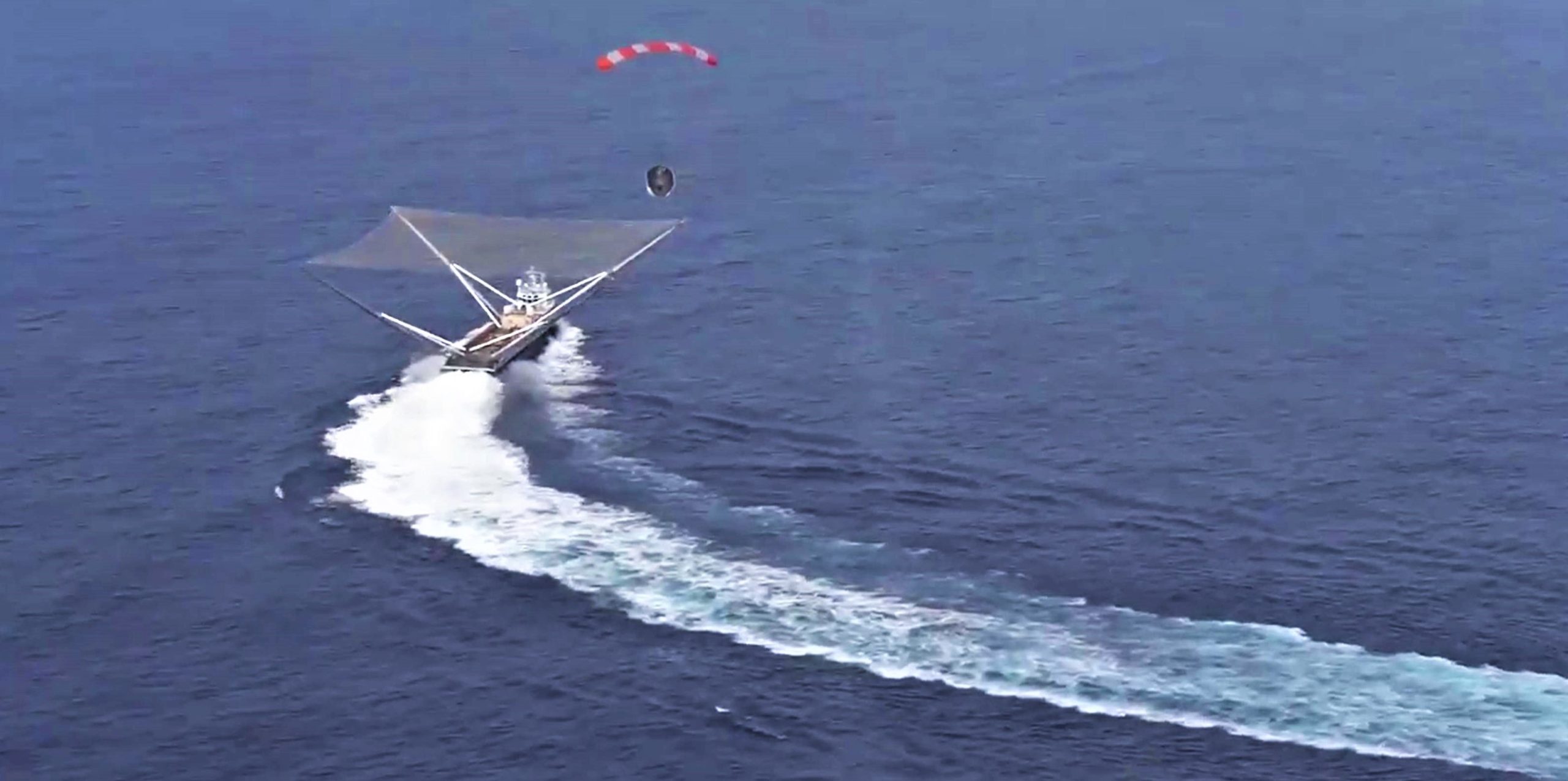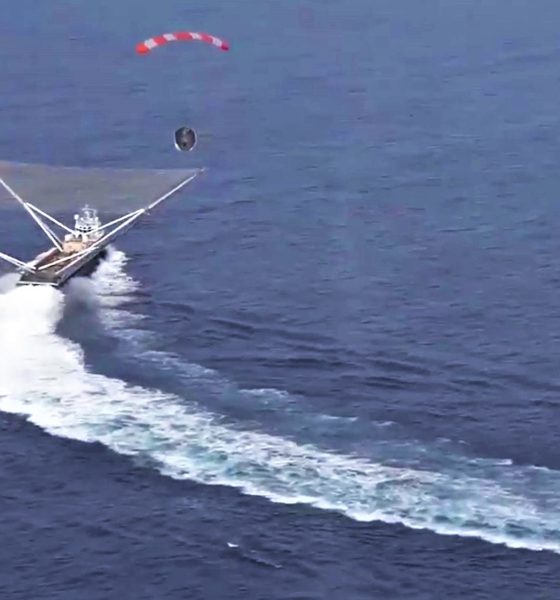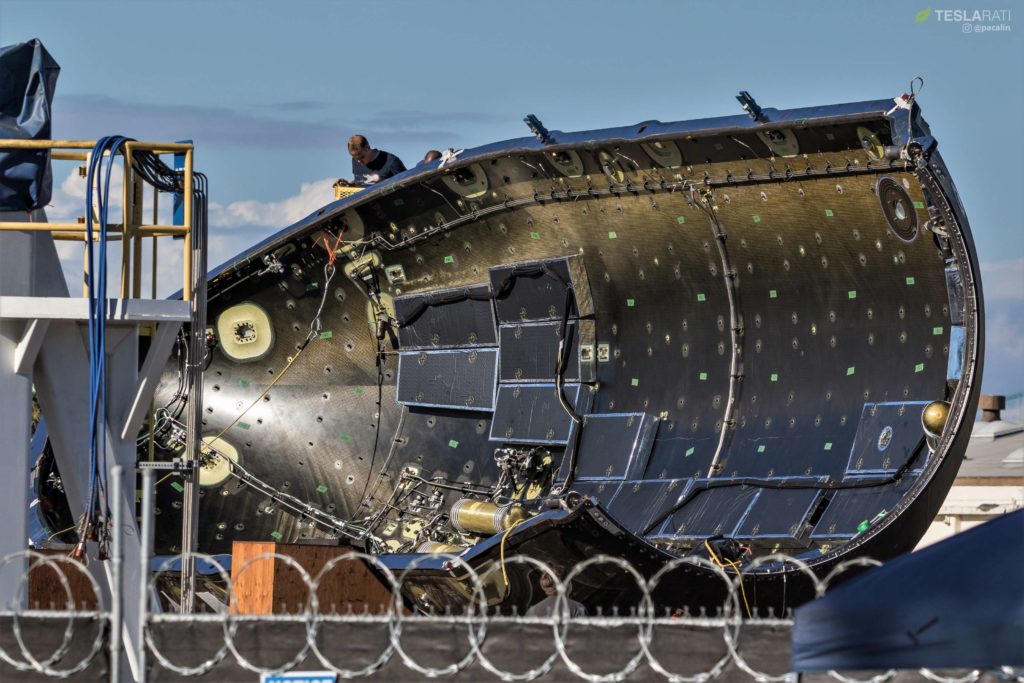

News
SpaceX reveals Falcon fairing recovery progress as Mr. Steven barely misses catch
SpaceX has offered an extraordinary glimpse into a stealthy program of Falcon fairing recovery research and development, which has utilized drop tests and iterative hardware and software upgrades to inch ever closer to fairing reuse over the last 6-9 months.
Short of a small handful of sparse comments made by executives in 2018, this is the first time SpaceX has officially acknowledged its continued attempts to optimize Falcon fairing recovery in the face of a number of missed post-launch catches. Given that the pictured fairing was so close to a successful landing that its parafoil actually became caught in Mr. Steven’s net, it seems that SpaceX has nearly solved the problems that have thus far prevented program success.
Recent fairing recovery test with Mr. Steven. So close! pic.twitter.com/DFSCfBnM0Y
— SpaceX (@SpaceX) January 8, 2019
In the last six months of 2018, SpaceX has continued to tease its slow progress towards reusable Falcon fairings, originally planned to depend on a truly bizarre solution – Mr. Steven. An impressive vessel on its own, SpaceX has gradually added and extended and upgraded a range of recovery hardware on his deck, most notably including a vast net (likely tens of thousands of square feet or 2000+ square meters) supported by four huge arms and eight supporting booms. Despite increasing the usable area of the net, SpaceX has been unable to secure an operational fairing catch since it began attempts in March 2018.
In late May 2018, SpaceX provided the best look yet at the actual process of recovering Falcon fairings, showing off the guided parafoil (a wing-like parachute) and revealing that a fairing half – launched in support of Iridium-6/GRACE-FO – had splashed down just 50 meters (~165 ft) away from Mr. Steven’s net.
Falcon 9 fairing halves deployed their parafoils and splashed down in the Pacific Ocean last week after the launch of Iridium-6/GRACE-FO. Closest half was ~50m from SpaceX’s recovery ship, Mr. Steven. https://t.co/JS7d5zTdIg pic.twitter.com/LjiTwnB4wd
— SpaceX (@SpaceX) May 31, 2018
However, in the months that followed, info about catch attempts became increasingly sparse and it eventually became clear that SpaceX was preparing to perform a range of controlled drop tests a few hundred miles off the coast of California. Ultimately, the company’s engineers and technicians hoped to use the controlled environment and a greater number of available drop/catch attempts to refine the hardware and software needed to finesse fairing halves into Mr. Steven’s net.
It may be almost absurdly large relative to any other conceivable thing that exists in the real world, but a few thousand square meters is actually more like a needle in a haystack for a piece of rocket traversing a 500-800 km arc at top speeds of more than 2 km/s.
- Mr. Steven seen after his most recent December 2018 drop and catch test. (Pauline Acalin)
- After an audible “3..2..1”, a sharp noise much like compressed gas being released was followed by a clang as the harness dropped. (Pauline Acalin)
- SpaceX’s fairing recovery fleet technicians were seen performing a bit of an unexpected ride aboard a Falcon 9 fairing half on September 19th. (Pauline Acalin)
In December 2018, following another sadly unsuccessful fairing recovery attempt on the West Coast, SpaceX CEO Elon Musk revealed that engineers were also apparently looking into backup plans in case closing that last 50-meter gap turned out to be more expensive or complicated than it was worth. Most notably, he implied that SpaceX was interested in finding ways to waterproof and ultimately refly Falcon fairings even after soft-landings in seawater, whereas fairings are already capable of reliably landing intact in the ocean but cannot be reused due to seawater contamination and cracking caused by impact.
Falcon fairing halves missed the net, but touched down softly in the water. Mr Steven is picking them up. Plan is to dry them out & launch again. Nothing wrong with a little swim.
— Elon Musk (@elonmusk) December 3, 2018
Given just how close Mr. Steven appears to be to a successful in-net fairing recovery, it now seems implausible that SpaceX will choose just one of the two options at hand, likely instead progressing both development programs to points of success. Once fairings can both be successfully waterproofed and caught in Mr. Steven’s net, SpaceX will almost certainly have itself a foolproof solution to easy and reliable recovery and reuse even in bad sea states and stormy weather.
With the company’s first launch of 2019 probably just a few days away, chances seem good that SpaceX will attempt at least one more post-launch fairing recovery with Mr. Steven. Fingers crossed!
For prompt updates, on-the-ground perspectives, and unique glimpses of SpaceX’s rocket recovery fleet check out our brand new LaunchPad and LandingZone newsletters!

Elon Musk
Elon Musk confirms xAI’s purchase of five 380 MW natural gas turbines
The deal, which was confirmed by Musk on X, highlights xAI’s effort to aggressively scale its operations.

xAI, Elon Musk’s artificial intelligence startup, has purchased five additional 380 MW natural gas turbines from South Korea’s Doosan Enerbility to power its growing supercomputer clusters.
The deal, which was confirmed by Musk on X, highlights xAI’s effort to aggressively scale its operations.
xAI’s turbine deal details
News of xAI’s new turbines was shared on social media platform X, with user @SemiAnalysis_ stating that the turbines were produced by South Korea’s Doosan Enerbility. As noted in an Asian Business Daily report, Doosan Enerbility announced last October that it signed a contract to supply two 380 MW gas turbines for a major U.S. tech company. Doosan later noted in December that it secured an order for three more 380 MW gas turbines.
As per the X user, the gas turbines would power an additional 600,000+ GB200 NVL72 equivalent size cluster. This should make xAI’s facilities among the largest in the world. In a reply, Elon Musk confirmed that xAI did purchase the turbines. “True,” Musk wrote in a post on X.
xAI’s ambitions
Recent reports have indicated that xAI closed an upsized $20 billion Series E funding round, exceeding the initial $15 billion target to fuel rapid infrastructure scaling and AI product development. The funding, as per the AI startup, “will accelerate our world-leading infrastructure buildout, enable the rapid development and deployment of transformative AI products.”
The company also teased the rollout of its upcoming frontier AI model. “Looking ahead, Grok 5 is currently in training, and we are focused on launching innovative new consumer and enterprise products that harness the power of Grok, Colossus, and 𝕏 to transform how we live, work, and play,” xAI wrote in a post on its website.
Elon Musk
Elon Musk’s xAI closes upsized $20B Series E funding round
xAI announced the investment round in a post on its official website.

xAI has closed an upsized $20 billion Series E funding round, exceeding the initial $15 billion target to fuel rapid infrastructure scaling and AI product development.
xAI announced the investment round in a post on its official website.
A $20 billion Series E round
As noted by the artificial intelligence startup in its post, the Series E funding round attracted a diverse group of investors, including Valor Equity Partners, Stepstone Group, Fidelity Management & Research Company, Qatar Investment Authority, MGX, and Baron Capital Group, among others.
Strategic partners NVIDIA and Cisco Investments also continued support for building the world’s largest GPU clusters.
As xAI stated, “This financing will accelerate our world-leading infrastructure buildout, enable the rapid development and deployment of transformative AI products reaching billions of users, and fuel groundbreaking research advancing xAI’s core mission: Understanding the Universe.”
xAI’s core mission
Th Series E funding builds on xAI’s previous rounds, powering Grok advancements and massive compute expansions like the Memphis supercluster. The upsized demand reflects growing recognition of xAI’s potential in frontier AI.
xAI also highlighted several of its breakthroughs in 2025, from the buildout of Colossus I and II, which ended with over 1 million H100 GPU equivalents, and the rollout of the Grok 4 Series, Grok Voice, and Grok Imagine, among others. The company also confirmed that work is already underway to train the flagship large language model’s next iteration, Grok 5.
“Looking ahead, Grok 5 is currently in training, and we are focused on launching innovative new consumer and enterprise products that harness the power of Grok, Colossus, and 𝕏 to transform how we live, work, and play,” xAI wrote.
Investor's Corner
Tesla gets price target bump, citing growing lead in self-driving

Tesla (NASDAQ: TSLA) stock received a price target update from Pierre Ferragu of Wall Street firm New Street Research, citing the company’s growing lead in self-driving and autonomy.
On Tuesday, Ferragu bumped his price target from $520 to $600, stating that the consensus from the Consumer Electronics Show in Las Vegas was that Tesla’s lead in autonomy has been sustained, is growing, and sits at a multiple-year lead over its competitors.
CES 2026 validates Tesla’s FSD strategy, but there’s a big lag for rivals: analyst
“The signal from Vegas is loud and clear,” the analyst writes. “The industry isn’t catching up to Tesla; it is actively validating Tesla’s strategy…just with a 12-year lag.”
The note shows that the company’s prowess in vehicle autonomy is being solidified by lagging competitors that claim to have the best method. The only problem is that Tesla’s Vision-based approach, which it adopted back in 2022 with the Model 3 and Model Y initially, has been proven to be more effective than competitors’ approach, which utilizes other technology, such as LiDAR and sensors.
Currently, Tesla shares are sitting at around $433, as the company’s stock price closed at $432.96 on Tuesday afternoon.
Ferragu’s consensus on Tesla shares echoes that of other Wall Street analysts who are bullish on the company’s stock and position within the AI, autonomy, and robotics sector.
Dan Ives of Wedbush wrote in a note in mid-December that he anticipates Tesla having a massive 2026, and could reach a $3 trillion valuation this year, especially with the “AI chapter” taking hold of the narrative at the company.
Ives also said that the big step in the right direction for Tesla will be initiating production of the Cybercab, as well as expanding on the Robotaxi program through the next 12 months:
“…as full-scale volume production begins with the autonomous and robotics roadmap…The company has started to test the all-important Cybercab in Austin over the past few weeks, which is an incremental step towards launching in 2026 with important volume production of Cybercabs starting in April/May, which remains the golden goose in unlocking TSLA’s AI valuation.”
Tesla analyst breaks down delivery report: ‘A step in the right direction’
Tesla has transitioned from an automaker to a full-fledged AI company, and its Robotaxi and Cybercab programs, fueled by the Full Self-Driving suite, are leading the charge moving forward. In 2026, there are major goals the company has outlined. The first is removing Safety Drivers from vehicles in Austin, Texas, one of the areas where it operates a ride-hailing service within the U.S.
Ultimately, Tesla will aim to launch a Level 5 autonomy suite to the public in the coming years.











